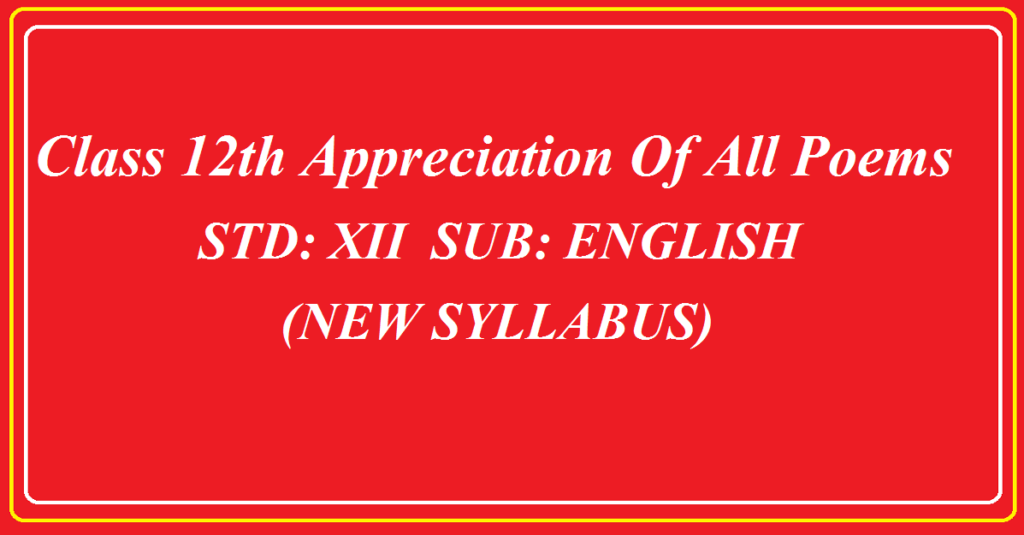Class 12th ENGLISH Appreciation Of All Poems
Class 12th ENGLISH Appreciation Of All Poems
STD 12th ENGLISH Appreciation Of All Poems (NEW SYLLABUS)
Class 12th Appreciation Of All Poems pdf
STD: XII SUB: ENGLISH (NEW SYLLABUS)
Sr. No. Name of the poem Poet/Poetess Known as
1 Song of the Open Road Walt Whitman Father of Free Verse
2 Indian Weavers Sarojini Naidu Nightingale of India
3 The Inchcape Rock Robert Southey Edgar Guest Poet Laureate of England
4 Have You Earned Your Tomorrow Dilip Chitre People’s poet
5 Father Returning Home William H. Davies Indian English poet and translator
6 Money George Gordon Byron Welsh poet and writer, spend life in UK and US
7 She Walks in Beauty Lord Byron, Romantic poet
8 Small Towns and Rivers Mamang Dai Indian poetess, active Radio and TV journalist
POETIC APPRECIATION All poems in the syllabus
2.1 Song of the Open Road
Walt Whitman [1819 to 1892]
About the poem, poet and the title
The poem ‘Song of the Open Road’ is written by an American poet Walt Whitman (1819 to 1892). He was a poet, an essayist and a journalist. He is called “The Father of Free Verse. He is known for his major literary works…..
- Leaves of Grass
- O Captain! My captain.
The poem ‘Song of the Open Road’ is taken from ‘Leaves of Grass’. It is a beautiful blend of self-awareness, free will and tenderness of heart.
The title of the poem is suggestive. The words “Song” and “Open Road” suggest happiness and freedom. The word road has multiple meaning. It signifies –
1) mobility
2) a point to start over towards new
3) Journeyof life.
Theme of the poem
Freedom, joy of free life and optimism are the major themes of this poem. The poet encourages the readers to be true to themselves, to live a life freely and enjoy the freedom of life. He also advocates to be aware about our responsibilities.
Poetic style
As the poet is the master of “Free Verse”, the poem “Song of the Open Road” is the fine example of it.
Irregular stanza, varied length of lines, use of parenthesis at the end, are its remarkable features.
The poem is full of various figurers of speech like Alliteration, Metaphor, Repetition, Paradox; imageries like ‘constellations’, ‘long brown path’ etc. add the beauty.
Language / Poetic Devices in the poem
The poem is written in a simple and effective language which is easy to understand. It is written in a Free Verse so there is no rhyme scheme and metre. The poem consists of beautiful and vivid imageries, like ‘long brown path’. It is also full of various figures of speech like Metaphor, Personification, Repetition, Alliteration etc.
Special Features
The poem is remarkable for….
1) Free Verse structure
2) Irregular stanzas.
3) Irregular length of lines and stanza symbolizing the complexities / difficulties one has to face in life.
4) Vivid imageries in the poem.
Message/Morals/values in the poem
The poem teaches us to be optimistic and to be happy. It encourages us to enjoy the life in healthy and free world. Also it motivates us to fill our heart with immense pleasure.
My Opinion about the poem.
I really appreciate the poem because the poem carries the theme of freedom and joy of life. The poem is full of optimism and teaches us to enjoy the immense pleasure of life.
2.2 Indian Weavers
Sarojini Naidu [1879 to 1949]
About the poem, poet and the title.
The poem “Indian Weavers” focuses over Indian artisan the weavers. The adjective Indian, in the title is used with a definite purpose appreciating the work of Indian weavers. It is apt and suitable.
Sarojini Naidu, the poetess of this poem was…..
a political activist and the first Indian woman to become the President of Indian National Congress.
Later she became the Governor of the United Provinces in 1947, the first woman to hold the office of the Governor.
She is known as the ‘Nightingale of India’ for her literary work.
Theme of the poem
The poem consists / depicts the picture of weavers weaving the clothes at three particular times of a day. These three particular times- namely the morning, the evening and the night symbolizes three particular stages of human life childhood, adulthood, and the end/ death of life respectively.
Poetic style
The poem consists of a three regular stanzas, and it is short and compact in the form. It is full of symbolism. Each stanza of the poem represents the three important events of life: birth (childhood), adulthood (youth) and death (old age). Regular rhyme and structures of the poem is its remarkable feature.
Language and poetic devices
The poem has a conversational tone. Poet, in every stanza, asks the weaver what he was doing, and the weaver replies.
The poem has regular rhyme – aabb.
Imageries like ‘break of day’, ‘fall of night’, ‘chill moonlight’ make the poem rich.It also consists of various figures of speech like Alliteration, simile, Metaphor, Symbol, Interrogation etc.
Special Features
1) Symbols in the poem.
2) Use of rhyme and regular structure
3) Depiction of three stages of human life.
4) Rich imagery.
5) Poem can be sung as a song.
Message / Values / Morals in the poem.
1) Life is just like a clothes full of various colours of happiness and sorrow.
2) As there are three times of day, there are also three stages of human life everyone has to go through.
3) Life begins with joy, hope, aspiration and happiness, runs with actions, adventures, progress, struggle and achievements and ends with sorrows, griefs and sadness.
My Opinion about the poem
I really appreciate the symbolism in the poem.
The times of a day symbolizing the stages of life, is noteworthy.
The various colours also symbolise the various stages of life.
The poem itself is a fabric / cloth intertwined perfectly.

